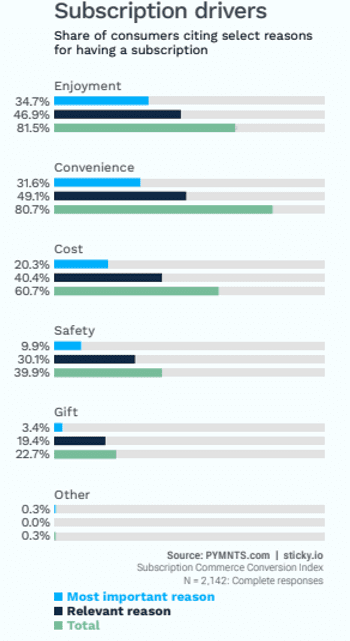Study: Consumers Keep Subscriptions for the Fun Factor

Emerging through the pandemic, battling the relentless tide of inflation, stock market routs, airport delays, you name it, it makes sense that as summer alights (and beyond), we’d all like to have a little breather, a bit of whimsy perhaps.
And for merchants, to keep subscriptions humming, to keep the connected economy connected, to make it all memorable, making it fun is sound strategy.
The connected economy is in growth mode, to be sure, with a significant greenfield opportunity ahead. Across several pillars of interaction — across daily activities spanning finance, commerce, feeding the family, getting from point A to point B — technology and apps and mobile devices are at the center of it all.
Increasingly, subscription services make some of that life navigation a bit easier. As detailed in the latest edition of the Subscription Commerce Conversion Index, a PYMNTS collaboration with sticky.io, we found there is a seemingly never-ending range of choice for recurring delivery of goods and services. To that end, the average consumer has nearly four subscriptions in hand at any one time.
Read more: Study Finds Subscribers Pay up for Convenience, Even With Inflation
Competing on More Than Price
And with so much choice in the mix, it’ no surprise that price is simply not the competitive advantage that one might have seen, oh, as recently as before the pandemic. In fact, PYMNTS data, gleaned from hundreds of merchants and more than 2,100 consumers, showed that only 20% of consumers said they chose subscriptions just to save money.
While that may seem a bit counterintuitive in an age where inflation is running at 40-year highs, that data point showed that merchants are finding new and novel ways to differentiate themselves from peers. Price was a key point of initial engagement for 60% of consumers, but then it seemed to fall a bit by the wayside once people actually started to pull the trigger and converted their browsing into buying, and ultimately signing on to a subscription or bundled package.
It’s the fun factor.
The same study showed that 66% of consumers — a majority, as seen in the chart below — valued enjoyment and convenience over pretty much any other factor.
 It’s here that we start to see merchants get creative — and they need to — in order to gain eyeballs and wallet share. If price is no longer a key determinant (it was during the pandemic, as the chart showed) then companies must find ways to engage with individuals as those individuals move through the day with their devices.
It’s here that we start to see merchants get creative — and they need to — in order to gain eyeballs and wallet share. If price is no longer a key determinant (it was during the pandemic, as the chart showed) then companies must find ways to engage with individuals as those individuals move through the day with their devices.
Play-to-earn models may be a key way to cement loyalty and to keep people on platforms and subscribing, while at the same time keeping churn down. We’re seeing subscription models transform verticals such as the travel industry, where exotic locales and getaways introduce a bit of dreaming and wanderlust into the mix.
Read more: Subscription Travel Brings Recurring Summer Fun to the Road and Skies
Gamification, too, can shift the emphasis away from price and onto convenience and fun. Apps use artificial intelligence (AI) and machine learning (ML) to keep consumers engaged with points and a higher level of interaction and communication that works on a personal level.
All of this plays to the fact that in the connected economy, behaviors tend to cross-pollinate. Payments are just part of the picture, leading us to explore social media, which then leads to new products and services we’ve never before considered. For the companies looking to boost their recurring revenues, the key is to make it fun.
